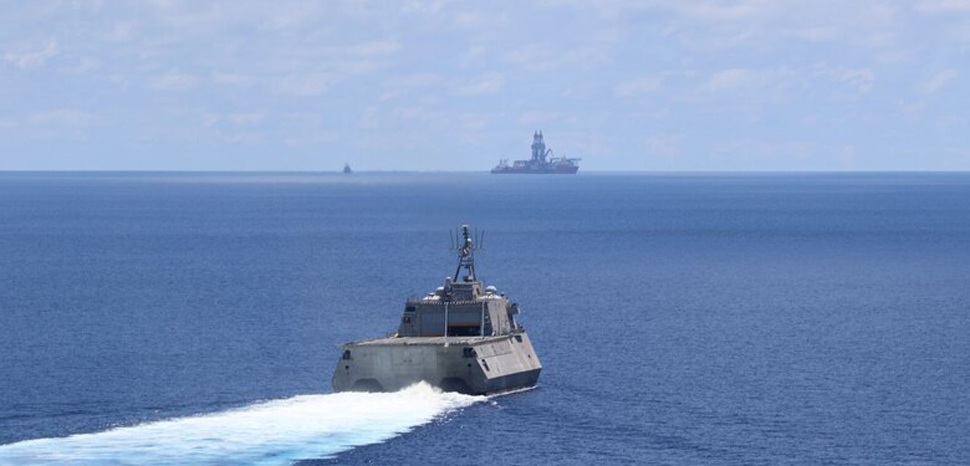“Some voices warn that the Indo-Pacific is actually code for geopolitical agendas: America’s bid to thwart China, India’s play for greatness, Japan’s plan to regain influence, Indonesia’s search for leverage, Australia’s alliance-building, Europe’s excuse to gatecrash the Asian century” writes Rory Medcalf in Indo-Pacific Empire. But it is in this region that America’s allies and partners are maritime sentinels, with their binoculars in hand, scanning the horizon for signs of further Chinese militarization, illegal fishing fleets, and additional U.S. Navy vessels as a result of a new Pentagon budget.
Since the U.S. Congressional Budget Office reports that the federal budget deficit will be upwards of $3.7 trillion in the current fiscal year and exceed $2 trillion in fiscal year 2021 as a result of spending on COVID-19 response and recovery, the operational readiness and funding of the U.S. armed forces from the Pacific to the Indian oceans may be undermined at a time when China is expanding its maritime nationalism in the South China Sea.
The recent bipartisan U.S. defense bill authorization of $740 billion for fiscal 2021 signals a commitment to restore and expand comparative advantage over China’s widening sphere of influence, and prioritizes the region by establishing the Indo Pacific Deterrence Initiative (IPDI) to bolster U.S. regional credibility and to enhance confidence among allies and comprehensive partners.
Although the defense bill, including the IPDI, has advanced through both chambers, it must cautiously navigate through a deliberate conference process to reconcile the differences between the House and Senate versions.
With the U.S. Congress in recess, it leaves behind a budget stand-off along party-lines over the extension of Coronavirus Aid, Relief and Economic Security Act (CARES) funding for millions of Americans who are suffering the dire economic consequences of the health storm and the real threat of a White House veto over the defense bill.
“The present consequences of the COVID-19 pandemic and ballooning national debt will assuredly impact on the Department of Defense’s (DOD) budget, irrespective of who wins the election in November and DOD is in for some lean years,” says Bryan McGrath, managing director of the FerryBridge Group, a niche consultancy specializing in Naval and national security issues based in Maryland.
To be clear, there is a history of military cuts when deficits get high, including in the 1980s during the later years of the Reagan administration, and in the 2010s during the Obama administration following the 2008-2009 recession.
If looming cuts to the DoD seem inevitable, the timing is unclear. Historically, cuts to national security spending have lagged in challenging economic times. The COVID-19 pandemic has not made the world safer; old threats have not gone away and new ones remain on the horizon, especially in the roiling South China Sea.
While the Trump administration supports enactment of a National Defense Authorization Act (NDAA) for a 60th consecutive year, the threat of a veto is not uncommon”, says Claude Chapin, communications director for U.S. House Representative, Mac Thornberry, a Republican from Texas. Democratic Representative Adam Smith Washington, chair of the House Armed Services Committee, in a rare display of bipartisanship, named the defense bill after his colleague, Thornberry. Both of them share a common view that there must be push-back on China’s harassment and maritime claims in the Spratly and Paracel Islands.
Despite the administration’s recognition that the bill strengthens alliances, attracts new partners, and supports the backbone of America’s national security, the White House has rejected the bill’s provisions on the renaming of certain military installations, and the micromanagement and transparency requirements placed on executive branch authority; thus the bill is threatened with a possible veto in its present form.
While the Pentagon’s budget request was met, Defense Secretary Mark Esper said efforts to control the deficit may jeopardize U.S. military modernization efforts. “I am concerned that the massive infusion into the economy by the Congress and the executive branch — nearly $3 trillion — may throw us off that course,” he said during a recent scheduled webinar.
The White House Indo-Pacific concept endorses the conventional building blocks of U.S. engagement in the region by building collective security through a network of regional allies and partners.
U.S. foreign policy and national security has long been based on the belief that maintaining a “free and open” Pacific requires the United States to prevent the rise of a regional power that could restrict U.S. access or establish a more insular regional order inimical to U.S. interests. Meanwhile, there’s little sign of tamping down the assailing rhetoric between Beijing and Washington.
However, in the region, Taiwan and Vietnam may be left standing without a “dance card” when it comes to the U.S. defense appropriations because of the severe economic impacts of the coronavirus. Both countries are counting on Senate approval of the $6.9 billion Indo-Pacific Reassurance Initiative (IPRI) in the proposed new NDAA.
The funds are slated to provide assistance in efforts to curb China’s claims to offshore resources across most of the South China Sea. This section of the defense bill did meet with the administration’s approval, as found in an Office of Management and Budget memo. The statement reads, “The administration looks forward to working with the committee on the IPRI to maintain a credible deterrent and demonstrate an enduring (U.S. government) commitment to the region.”
According to a report by the Brookings Institute, “The U.S. alliance and partnership network has been the centerpiece of American strategy in Asia since World War II, and the principal is the means through which the United States promotes collective security in the Indo-Pacific.”
A sense of shared concern about the spectrum of Chinese influence has helped propel new momentum for seeking bilateral relationships, facilitating combined naval operations in the South China Sea and, in the case of Vietnam, regular port calls in Danang. These include the arrival of the USS Theodore Roosevelt carrier in March, where it was met by both Vietnamese and U.S. government and military officials.
The carrier USS Carl Vinson made its first historic visit to Danang in March 2018. There have also been U.S. port calls to Cam Ranh Bay. This location served as a major air force base during the Vietnam War and as a naval seaport for offloading supplies and military equipment.
While Vietnam has been “quite vocal and supportive” of U.S. freedom-of-navigation operations near islands claimed by China in the South China Sea, Hanoi remains wary of Washington’s assurances it will offer in offer assistance in curbing China’s actions.
With the U.S. national election only a few months away, the Trump administration seems certain to ratchet up its language in describing the “geopolitical competition between free and repressive visions of world order” underway in the Indo-Pacific region, with China seeking to “challenge American power, influence, and interests … [and] erode American security and prosperity.
Based on the convergence of Vietnamese and U.S. strategic interests in the South China Sea, US-Vietnam security cooperation has significantly expanded during the past decade.
“Vietnam and the United States have held on and off again discussions about raising their Obama era comprehensive partnership to a strategic partnership. In light of China’s persistent bullying of Vietnam over sovereignty, maritime disputes and oil exploration in the South China Sea some analysts argue that the “circumstances and specific conditions” may have arisen for a change of policy,” claims Carl Thayer, an Emeritus Professor at the University of New South Wales and consultant in a recent Diplomat article.
With China’s bold incursions into EEZs, both Taiwan and Vietnam face unprecedented challenges to their sovereignty, prosperity, and peace. Consistent with the Taiwan Relations Act, the United States supports an effective deterrence capability for Taiwan.
U.S. Health Secretary Alex Azar, as the highest-level U.S. official to visit in forty years, attacked China’s response to the coronavirus pandemic during a recent trip to Taiwan. His arrival in Taipei, intended to strengthen public health cooperation with the Republic of China, only served to raise the Chinese Communist Party’s temperature level, resulting in a swift government condemnation since Beijing believes that “reunification” is inevitable and has vowed it will never tolerate Taiwan’s independence.
According to Bloomberg News, on the footsteps of Secretary Azar’s visit, Taiwan finalized the purchase of F-16 fighter jets from the U.S. manufacturer, Lockheed Martin, in a $62 billion, 10-year deal almost certain to increase tensions with Beijing. Washington does remain Taiwan’s most powerful ally and its main supplier of arms, despite switching diplomatic recognition from Taipei to Beijing in 1979.
Last month, the White House and the U.S. State Department in a series of high-level statements explicitly rejected China’s maritime claims in the South China Sea as inconsistent with the United Nations Convention on the Law of the Sea (UNCLOS) that underpins a rules-based maritime order.
The U.S. statement is very telling and underscores the prominence of the Indo-Pacific as strategic to the U.S. “As Beijing has failed to put forth a lawful, coherent maritime claim in the SCS, the U.S. rejects any PRC (People’s Republic of China) claim to waters beyond a 12-nautical mile territorial sea derived from islands it claims in the Spratlys (Vietnam’s Truong Sa).”
A strong, rules-based architecture anchors the U.S. vision for the Indo-Pacific region. Representing ten countries, 650 million people, and a combined GDP of almost $3 trillion, the Association of Southeast Asian Nations (ASEAN) is central to this architecture.
Marine traffic analysts revealed that the Ronald Reagan Strike Group entered the South China Sea conducting high-end maritime stability operations through the northwest portion of Japan in support of a free and open waters.
Despite an unsteady relationship with Washington, the Philippines is one of America’s oldest Asian partners. As a result, the Philippine-US Visiting Forces Agreement remains in place especially in light of on-going Chinese incursions into their EEZ.
Zach Cooper of the American Enterprise Institute anticipates increasing pressure over the next year on any modified defense budget, since the economic crisis caused by COVID-19 has driven up debt by several trillion dollars, triggering renewed concerns about discretionary spending.
“If Democrats win the Senate and or the presidency, there will be more interest in social spending, which would have to be offset by higher taxes or decreased spending elsewhere,” says Cooper.
He along with other analysts, do not see any interruptions in Freedom of Navigation Operations (FONOPs), but believe they will not increase through the remainder of the year. The Trump administration has made it clear that they are deploying other tools, including legal and economic options, to ensure that Beijing pays a cost for destabilizing behavior in the region.
With no clear signs that a defense bill that includes the Pacific Deterrence Initiative will be signed into law, America’s comprehensive and treaty partners remain ever vigilant in this hazardous rocky seascape.
James Borton is a senior writer and researcher who has been reporting on Southeast Asia and the South China Sea for over two decades. He’s currently writing Dispatches from the South China Sea: The Search for Common Ground.
The views expressed in this article are those of the authors alone and do not necessarily reflect those of Geopoliticalmonitor.com or any institutions with which the authors are associated.




